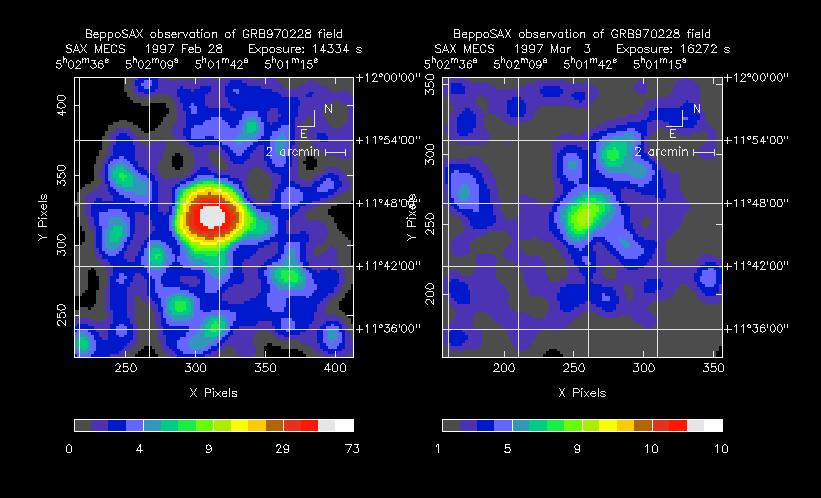
 Credit: BeppoSAX Science Data Center (SDC) and the Agenzia Spaziale Italiana (ASI)
Credit: BeppoSAX Science Data Center (SDC) and the Agenzia Spaziale Italiana (ASI)
Catching the First Burst
There was a time when the nature of Gamma-ray bursts (GRBs) was a complete mystery. This was largely because early
Gamma-ray observatories had difficulty localizing these bursts in the seconds to minutes before the burst faded.
Detection by X-ray, UV and optical telescopes could potentially localize a
GRB and identify the source of the emission. But for decades no one knew for sure if GRBs even emitted any lower-energy radiation, and, even if they did, catching the short-lived
burst simultaneously with a both Gamma-ray and X-ray telescopes telescopes would
require difficult coordination between the two independent observatories.
The breakthrough was made by the Italian-Dutch X-ray satellite BeppoSAX.
BeppoSAX carried on-board a Gamma-ray
burst monitor along with a sophisticated X-ray telescope. On 28 February 1997, a
Gamma-ray burst was discovered simultaneously by the BeppoSAX Gamma Ray Burst Monitor and its Wide
Field X-ray Cameras by a team of Italian/Dutch scientists at the
Scientific Operations Center in Nuova Telespazio, Rome. The Italian
scientists responsible for the Gamma-ray burst detector onboard the
satellite, quickly working with the Mission Scientist and the Mission
Director, were able to reschedule the satellite
observations. In only 8 hours, the operations team was able to point the high-resolution X-ray telescopes (the Low
Energy Concentrator Spectrometer and the Medium
Energy Concentrator Spectrometer) at the Gamma-ray
burst. As a result, an unknown X-ray source, in the constellation of
Orion, was discovered and localized. A second follow-up was performed with narrow field instruments
after about 2 days. This second observation showed that the source faded by about a factor of 20, confirming that this transient X-ray source
and the transient Gamma-ray source were one and the same. The BeppoSAX X-ray
images taken during the two follow-up observations are shown in the
figure above.
These X-ray observations, and
subsequent observations in the radio and optical, revealed
that this Gamma-ray burst source came from a star-forming
galaxy and showed, for the first time, that Gamma-ray bursts were extremely powerful explosions from beyond the Milky Way.
Published: August 20, 2018
<
HEA Dictionary ● Archive
● Search HEAPOW
● Other Languages
● HEAPOW on Facebook
● Download all Images
● Education ● HEAD
>

Each week the HEASARC
brings you new, exciting and beautiful images from X-ray and Gamma ray
astronomy. Check back each week and be sure to check out the HEAPOW archive!
Page Author: Dr. Michael F. Corcoran
Last modified Tuesday, 27-Feb-2024 10:15:17 EST


